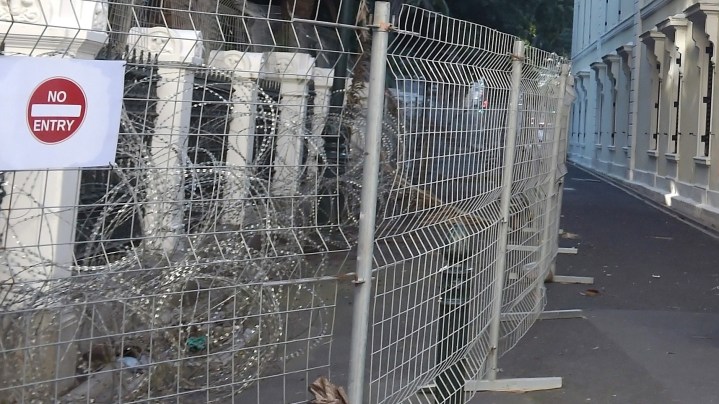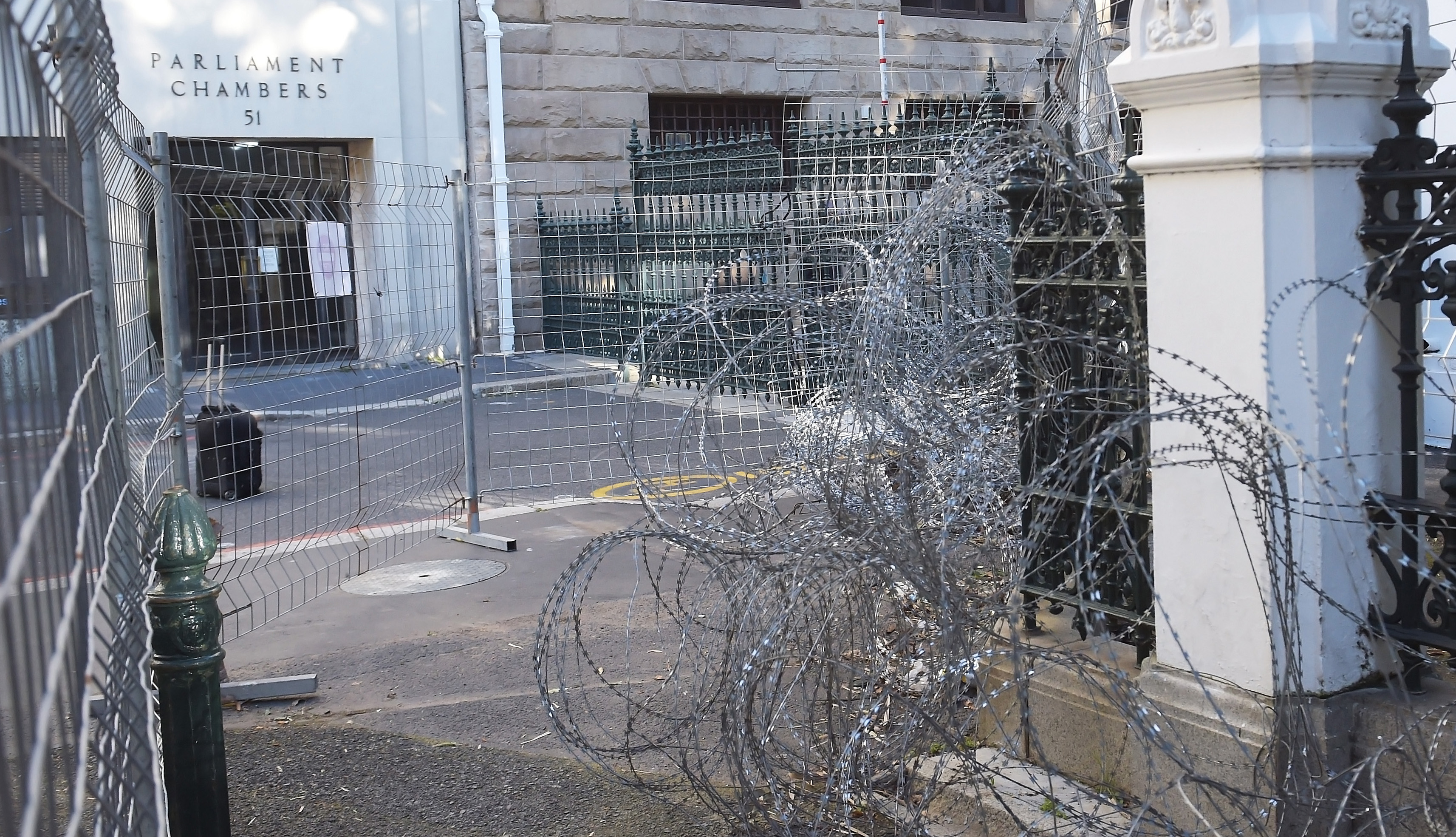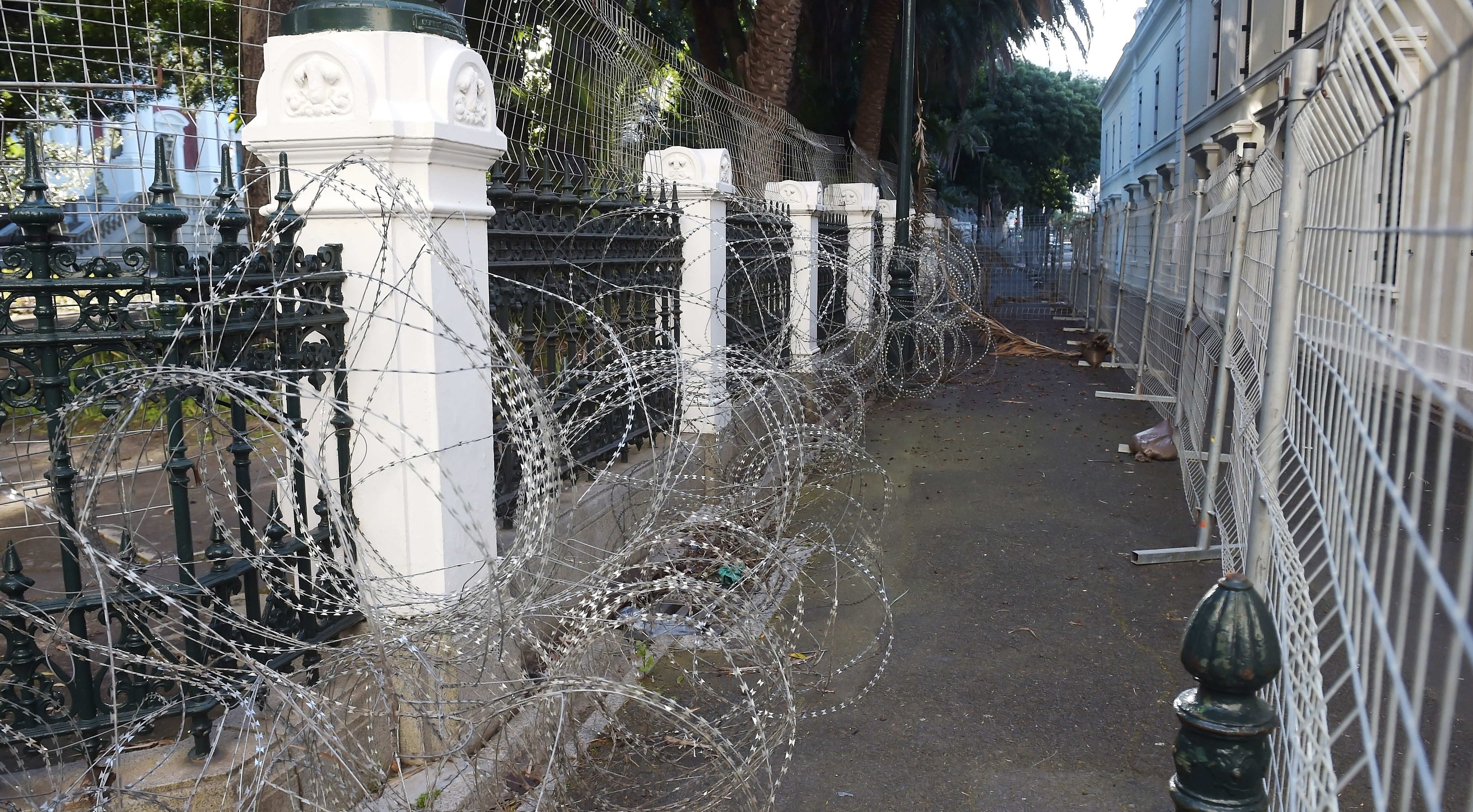PARLIAMENT
Parliamentary precinct: SAPS put up razor wire to keep out outsiders – but now investigates GBV assault among its ranks

A male police sergeant was shifted from Parliament to a police station after hitting a woman sergeant in the precinct, Daily Maverick has been reliably informed. It’s just one inside incident since the SAPS invoked security and national key point status to cordon off the national legislature.
The gender-based violence (GBV) incident involving the two sergeants, whose names are known to Daily Maverick, was at least in part caught on camera and, according to the parliamentary grapevine, came after their affair soured.
The police have confirmed “an internal departmental investigation is under way”, while an assault case also has been registered.
“The SAPS… follows a zero tolerance approach and tough stance to GBV, with its own officers not being immune to this,” national police spokesperson Colonel Athlenda Mathe said in a text message late on Tuesday.
The physical altercation between the two Parliament-based sergeants followed a mid-June security breach when a so-called trespasser followed a SAPS officer across the precinct from the gate near the Iziko Slave Lodge Museum all the way to the presidential Tuynhuys offices through a side-door that’s left open. One person was eventually arrested outside the precinct, it has been independently confirmed by two insiders.
Both incidents – and others including police caught napping on duty or focused on their phones – have unfolded against the police’s securitisation of the parliamentary precinct, in which rolls of razor wire were cable-tied to the Arch for the Arch, a monument honouring the late Archbishop Emeritus Desmond Tutu.
It is understood that the SAPS leveraged the June trespassing incident to roll out even more rolls of razor wire and makeshift fencing around the national legislature in a securocrat deflection after already having closed access to the historic Government Avenue and the Company’s Garden in the wake of the 2 January fire.
Security: Who’s in charge
In democratic South Africa, the SAPS is not in charge of safety and security at Parliament, but one of several players seconded to specifically assist, for example, with access control at gates. Police may only operate in the precinct with the express approval of the presiding officers, according to the 2004 Powers, Privileges and Immunities of Parliament and Provincial Legislature Act.
Parliament, as an independent sphere of state separate to the executive to which the police report, has its own safety and security – the Parliamentary Protection Services (PPS).
Once able to tell off the US security services for their demands during the 1998 state visit by then US president Bill Clinton, the PPS has been eviscerated. Since 2015 the PPS boss and deputy positions have remained vacant, first because of suspensions then because of lack of appointment, and parliamentary protection was downgraded into the household services as a unit, rather than continue as a standalone division.
That, however, may change as appointing a parliamentary protection boss, alongside an overhaul of safety and security protocols, was receiving urgent attention, according to Secretary to Parliament Xolile George at the 25 August Joint Standing Committee on the Financial Management of Parliament
These measures would ensure “predictability” and better coordination with others involved in Parliament’s safety and security, George said in a reference to the SAPS whose national commissioner, Lieutenant-General Fannie Masemola, he met.
Daily Maverick emailed detailed requests to the SAPS on Thursday, 25 August, and Parliament by Monday, for comment on, among other things, the GBV police and the other security breach incidents, the number of so-called jumpers trespassing in the precinct, whether it was appropriate for razor wire to surround the people’s assembly, the alleged national key point status, as well as the PPS.
Aside from the SAPS response to the GBV incident – and that the police did not comment on security measures at a national key point – no further responses have been received, and no replies have come from the national legislature. This is despite follow-up texts to Parliament and the SAPS.
However, some explanation if not on the numbers then the police’s motivation emerges in George’s correspondence to the DA dated 26 July, seen by Daily Maverick.
It talks about the SAPS’ concern about “increased number of security breaches via the perimeter fencing” at Parliament.
“These concerns were raised with Parliament and identified as a possible security threat. SAPS has since put a plan in place to address this security threat and have installed the extra security measures on the perimeter fencing to mitigate the risk. The extra security measures were installed by SAPS at their own cost to prevent illegal access through jumping over the fences,” writes the Secretary to Parliament.
“Parliament remains a people’s Parliament and members of the public are granted access to the precinct and parliamentary events within the existing processes of going through the visitor’s center [sic].”
That visitors’ centre has also been fenced since last week. The nearby bench remains wrapped in police crime-scene tape.

The back area of the Parliament of South Africa has been fenced with barbed wire. Photograph : Xabiso Mkhabela
Ironically, amid the razor wire, fencing and crime-scene tape security, left unattended is a broken CCTV camera that fell off its pole at the back of the National Council of Provinces earlier in August. According to what Daily Maverick has seen, at best that camera now records the flowerbed.
Mum on key points
The SAPS’ insistence on not commenting on what it claims are national key points dates back to Caryn Dolley’s Burning Assembly articles:
“The SAPS does not discuss security-related matters pertaining to National Key Points in the public domain,” was the repeat response.
Yet only the presidential Tuynhuys office, the ministerial offices at 120 Plein Street and what’s called Parliament House have been declared as national key points, according to the list released in January 2015 by then police minister Nkosinathi Nhleko after a successful Right2Know Campaign court application.
That’s the only publicly available information – and it means not declared national key points are various other buildings in the parliamentary precinct. They include the Marks Building, where most of the opposition is based, 90 and 100 Plein Street which house the committee and question sections, translation, legal services and other parliamentary administration, Africa House which houses the national legislature’s international section and meetings of the Joint Standing Committee on Intelligence, and the Good Hope Chamber, a committee venue until it was declared as the House for sittings.
This 2015 list may well have been updated, but since it’s not been published, nor is it in the public domain, put bluntly it means the veil of secrecy invoked during apartheid continues in today’s constitutional democracy – despite the Constitution’s founding values of transparency, responsiveness and openness.
Burning questions
The SAPS has long itched to take over the parliamentary precinct – as it controls the Union Buildings, for example – claiming the police are in charge of government installations.
That police have been able to do what it has in part is due to the impact of Covid-19 remote working – several MPs who have returned in recent months have told Daily Maverick of their surprise at the heightened security – and the 2 January fire that occurred on the SAPS’ watch.
A homeless man, Zandile Mafe, is set to go trial in the Western Cape High Court from 2 September on charges including housebreaking, terrorism, arson and theft.

The back area of the Parliament of South Africa (Photograph : Xabiso Mkhabela)
The PPS patrols that traditionally go through buildings in the parliamentary precinct had been stopped over weekends and public holidays. This was confirmed again during the 25 August meeting of the Joint Standing Committee on the Financial Management of Parliament.
“There [were] no Parliament Protection Services on site on the day of the fire. Parliament has not done its own investigation or root-cause analysis,” according to the Secretary to Parliament’s PowerPoint presentation. “Responsible (SAPS) staff on duty have been identified and internal SAPS processes are under way.”
Parliament has full control of its precinct, according to the law, but the razor wire, fencing parked police vehicles and control points across the precinct signal the SAPS’ intention to do what it deems appropriate for the people’s assembly.
It remains unclear, since the request for comment remained unanswered, whether the presiding officers have granted police the statutorily required express permission for the heightened security – including the unprecedented deployment of armed, uniformed police at the Section 194 inquiry into the suspended Public Protector.
Meanwhile, the City of Cape Town has made it clear that the razor wire and fencing must be cleared so access to Government Avenue and the Company’s Garden is restored by 1 September.
Whether that happens remains to be seen – as questions remain over the police presence in Parliament’s precinct and the DA and EFF push for Parliament to fully return to physical sittings. DM
















 Become an Insider
Become an Insider
Ironic that the ANC is foisting expropriation without compensation to the point where owners may not use security measures to defend property from invaders while they use every possible defence for their own.